Sainsbury HRM: Performance Appraisal, Recruitment, and Rewards Report
VerifiedAdded on 2020/11/12
|11
|3730
|111
Report
AI Summary
This report provides a comprehensive analysis of Human Resource Management (HRM) practices within Sainsbury, a UK-based retail enterprise. The report delves into the positive and negative aspects of performance appraisal and rewarding systems and their psychological impact on employees. It identifies the factors that influence employee motivation and confidence. Furthermore, the report examines Sainsbury's recruitment and selection policies and procedures, outlining the steps involved from vacancy identification to candidate selection, including the role of the HR department, advertising, interviewing, and background checks. The importance of reward systems in enhancing employee motivation is also evaluated, highlighting how various methods of rewarding contribute to improved performance. The report emphasizes the significance of documentation, structuring, motivation, and career growth in the appraisal process. It also addresses potential negative aspects such as bias, generalization errors, and severity/leniency issues. The recruitment section covers policy objectives, vacancy management, application processes, interview panels, and the final selection decision, with a focus on fairness and compliance with labor laws. Finally, the report discusses the role of training and support for managers involved in recruitment, ensuring a structured and ethical approach to HRM within the organization.
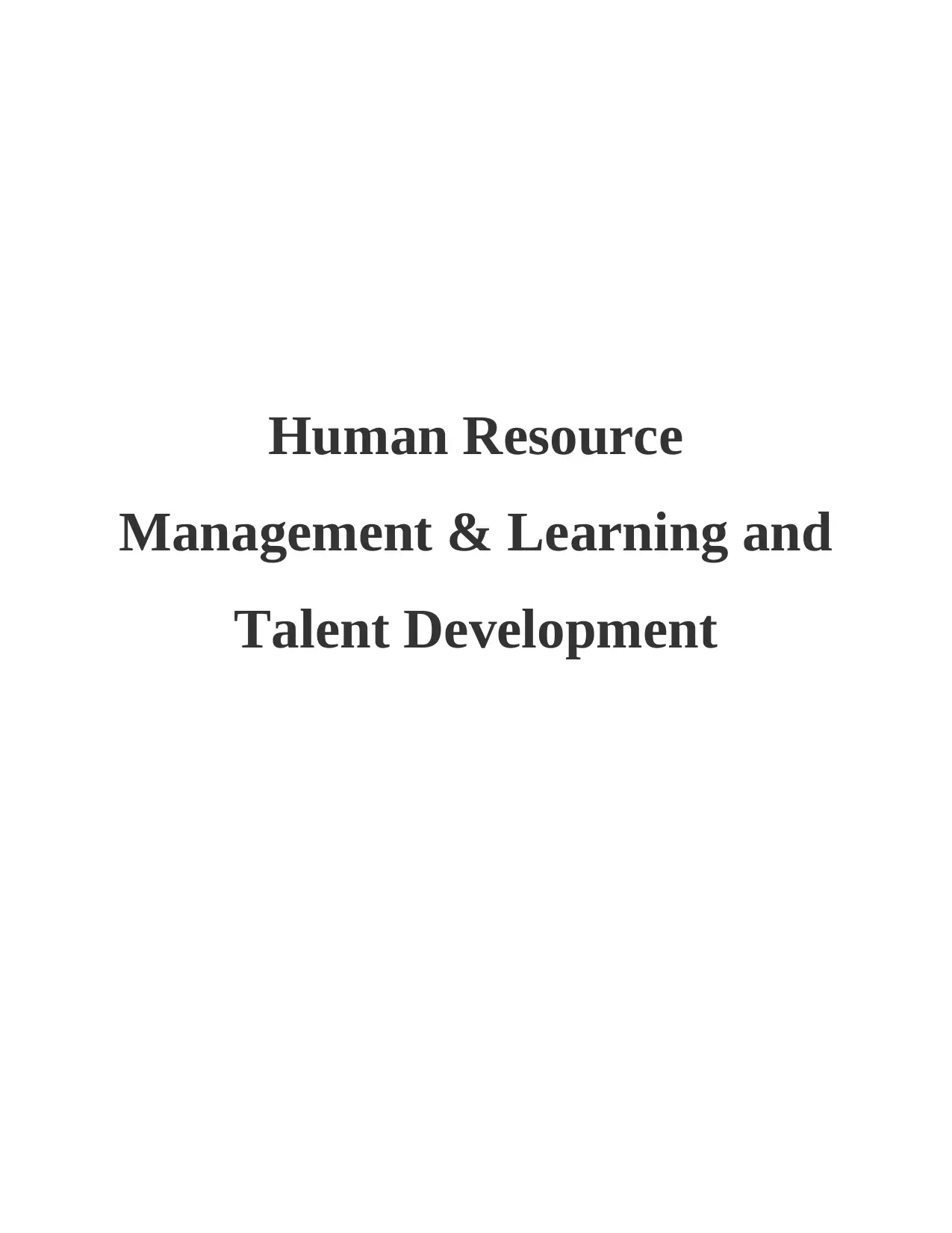
Human Resource
Management & Learning and
Talent Development
Management & Learning and
Talent Development
Paraphrase This Document
Need a fresh take? Get an instant paraphrase of this document with our AI Paraphraser

Table of Contents
INTRODUCTION...........................................................................................................................1
TASK ..............................................................................................................................................1
Q4. Identify positive and negative factors of performance appraisal and rewarding on
psychology of an employee.........................................................................................................1
Q 5.Recruitment and selection policy/procedure........................................................................3
Q 6. Importance of reward system in enhancing motivation......................................................6
CONCLUSION................................................................................................................................8
REFERENCES................................................................................................................................9
Books and Journals.....................................................................................................................9
INTRODUCTION...........................................................................................................................1
TASK ..............................................................................................................................................1
Q4. Identify positive and negative factors of performance appraisal and rewarding on
psychology of an employee.........................................................................................................1
Q 5.Recruitment and selection policy/procedure........................................................................3
Q 6. Importance of reward system in enhancing motivation......................................................6
CONCLUSION................................................................................................................................8
REFERENCES................................................................................................................................9
Books and Journals.....................................................................................................................9
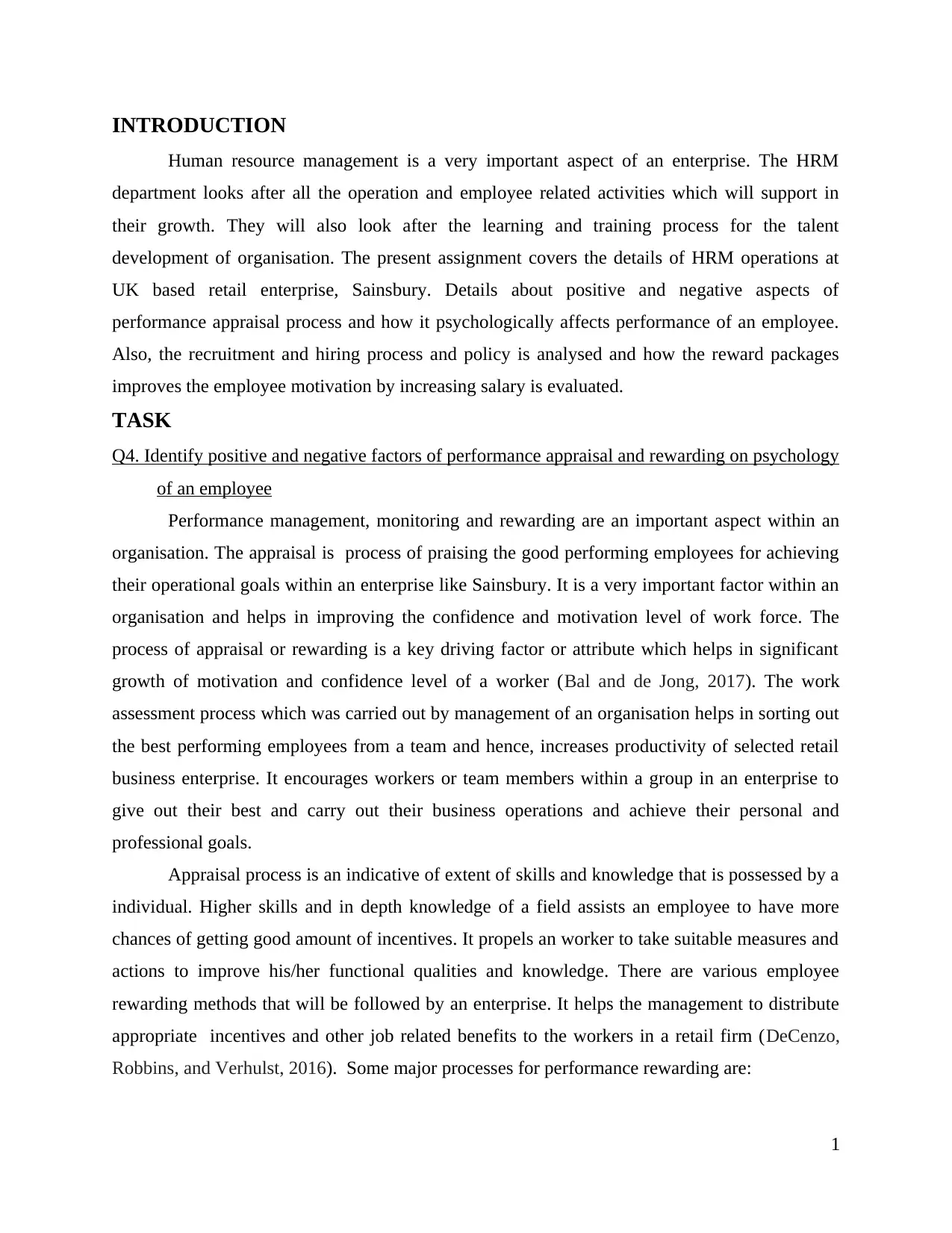
INTRODUCTION
Human resource management is a very important aspect of an enterprise. The HRM
department looks after all the operation and employee related activities which will support in
their growth. They will also look after the learning and training process for the talent
development of organisation. The present assignment covers the details of HRM operations at
UK based retail enterprise, Sainsbury. Details about positive and negative aspects of
performance appraisal process and how it psychologically affects performance of an employee.
Also, the recruitment and hiring process and policy is analysed and how the reward packages
improves the employee motivation by increasing salary is evaluated.
TASK
Q4. Identify positive and negative factors of performance appraisal and rewarding on psychology
of an employee
Performance management, monitoring and rewarding are an important aspect within an
organisation. The appraisal is process of praising the good performing employees for achieving
their operational goals within an enterprise like Sainsbury. It is a very important factor within an
organisation and helps in improving the confidence and motivation level of work force. The
process of appraisal or rewarding is a key driving factor or attribute which helps in significant
growth of motivation and confidence level of a worker (Bal and de Jong, 2017). The work
assessment process which was carried out by management of an organisation helps in sorting out
the best performing employees from a team and hence, increases productivity of selected retail
business enterprise. It encourages workers or team members within a group in an enterprise to
give out their best and carry out their business operations and achieve their personal and
professional goals.
Appraisal process is an indicative of extent of skills and knowledge that is possessed by a
individual. Higher skills and in depth knowledge of a field assists an employee to have more
chances of getting good amount of incentives. It propels an worker to take suitable measures and
actions to improve his/her functional qualities and knowledge. There are various employee
rewarding methods that will be followed by an enterprise. It helps the management to distribute
appropriate incentives and other job related benefits to the workers in a retail firm (DeCenzo,
Robbins, and Verhulst, 2016). Some major processes for performance rewarding are:
1
Human resource management is a very important aspect of an enterprise. The HRM
department looks after all the operation and employee related activities which will support in
their growth. They will also look after the learning and training process for the talent
development of organisation. The present assignment covers the details of HRM operations at
UK based retail enterprise, Sainsbury. Details about positive and negative aspects of
performance appraisal process and how it psychologically affects performance of an employee.
Also, the recruitment and hiring process and policy is analysed and how the reward packages
improves the employee motivation by increasing salary is evaluated.
TASK
Q4. Identify positive and negative factors of performance appraisal and rewarding on psychology
of an employee
Performance management, monitoring and rewarding are an important aspect within an
organisation. The appraisal is process of praising the good performing employees for achieving
their operational goals within an enterprise like Sainsbury. It is a very important factor within an
organisation and helps in improving the confidence and motivation level of work force. The
process of appraisal or rewarding is a key driving factor or attribute which helps in significant
growth of motivation and confidence level of a worker (Bal and de Jong, 2017). The work
assessment process which was carried out by management of an organisation helps in sorting out
the best performing employees from a team and hence, increases productivity of selected retail
business enterprise. It encourages workers or team members within a group in an enterprise to
give out their best and carry out their business operations and achieve their personal and
professional goals.
Appraisal process is an indicative of extent of skills and knowledge that is possessed by a
individual. Higher skills and in depth knowledge of a field assists an employee to have more
chances of getting good amount of incentives. It propels an worker to take suitable measures and
actions to improve his/her functional qualities and knowledge. There are various employee
rewarding methods that will be followed by an enterprise. It helps the management to distribute
appropriate incentives and other job related benefits to the workers in a retail firm (DeCenzo,
Robbins, and Verhulst, 2016). Some major processes for performance rewarding are:
1
⊘ This is a preview!⊘
Do you want full access?
Subscribe today to unlock all pages.

Trusted by 1+ million students worldwide
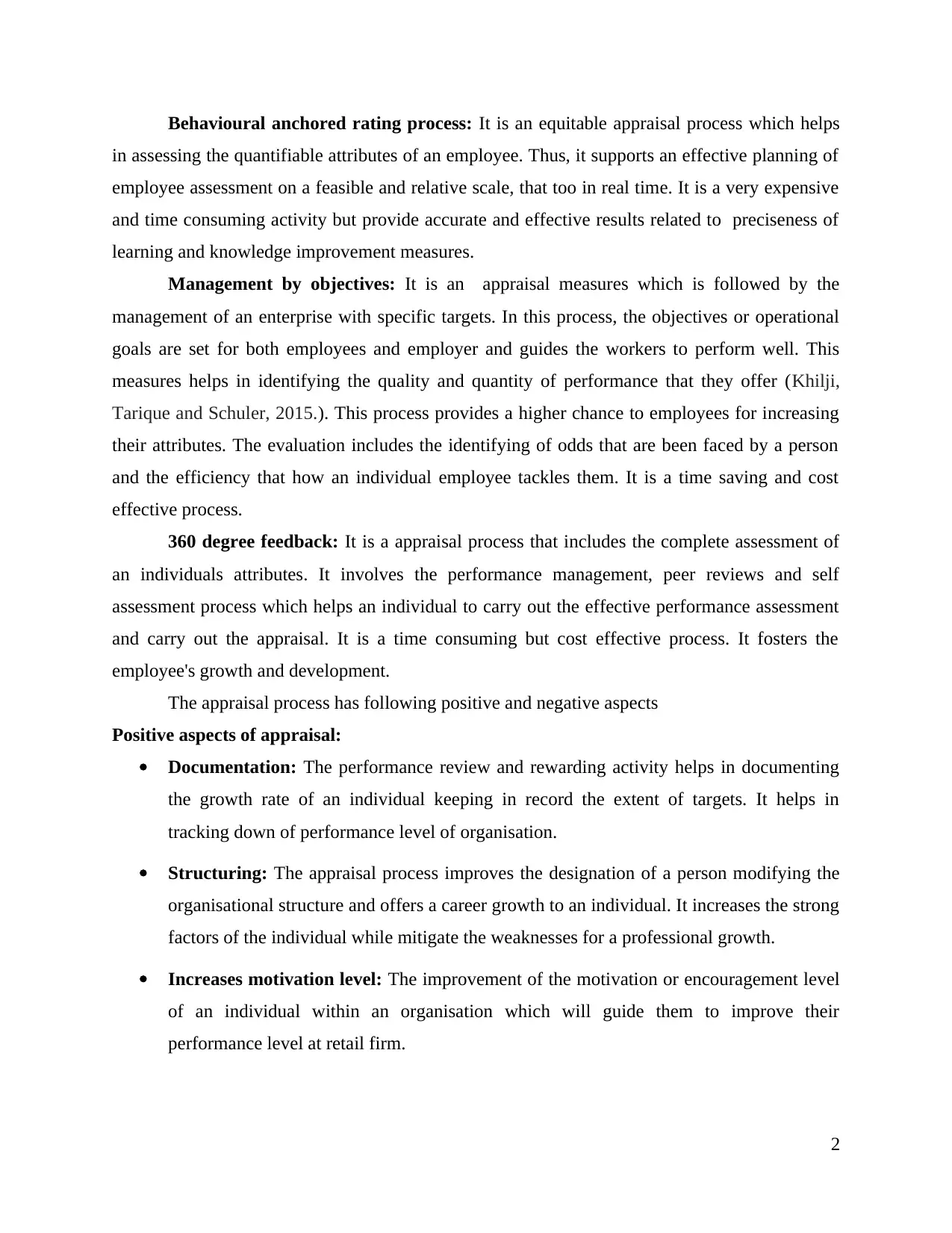
Behavioural anchored rating process: It is an equitable appraisal process which helps
in assessing the quantifiable attributes of an employee. Thus, it supports an effective planning of
employee assessment on a feasible and relative scale, that too in real time. It is a very expensive
and time consuming activity but provide accurate and effective results related to preciseness of
learning and knowledge improvement measures.
Management by objectives: It is an appraisal measures which is followed by the
management of an enterprise with specific targets. In this process, the objectives or operational
goals are set for both employees and employer and guides the workers to perform well. This
measures helps in identifying the quality and quantity of performance that they offer (Khilji,
Tarique and Schuler, 2015.). This process provides a higher chance to employees for increasing
their attributes. The evaluation includes the identifying of odds that are been faced by a person
and the efficiency that how an individual employee tackles them. It is a time saving and cost
effective process.
360 degree feedback: It is a appraisal process that includes the complete assessment of
an individuals attributes. It involves the performance management, peer reviews and self
assessment process which helps an individual to carry out the effective performance assessment
and carry out the appraisal. It is a time consuming but cost effective process. It fosters the
employee's growth and development.
The appraisal process has following positive and negative aspects
Positive aspects of appraisal:
Documentation: The performance review and rewarding activity helps in documenting
the growth rate of an individual keeping in record the extent of targets. It helps in
tracking down of performance level of organisation.
Structuring: The appraisal process improves the designation of a person modifying the
organisational structure and offers a career growth to an individual. It increases the strong
factors of the individual while mitigate the weaknesses for a professional growth.
Increases motivation level: The improvement of the motivation or encouragement level
of an individual within an organisation which will guide them to improve their
performance level at retail firm.
2
in assessing the quantifiable attributes of an employee. Thus, it supports an effective planning of
employee assessment on a feasible and relative scale, that too in real time. It is a very expensive
and time consuming activity but provide accurate and effective results related to preciseness of
learning and knowledge improvement measures.
Management by objectives: It is an appraisal measures which is followed by the
management of an enterprise with specific targets. In this process, the objectives or operational
goals are set for both employees and employer and guides the workers to perform well. This
measures helps in identifying the quality and quantity of performance that they offer (Khilji,
Tarique and Schuler, 2015.). This process provides a higher chance to employees for increasing
their attributes. The evaluation includes the identifying of odds that are been faced by a person
and the efficiency that how an individual employee tackles them. It is a time saving and cost
effective process.
360 degree feedback: It is a appraisal process that includes the complete assessment of
an individuals attributes. It involves the performance management, peer reviews and self
assessment process which helps an individual to carry out the effective performance assessment
and carry out the appraisal. It is a time consuming but cost effective process. It fosters the
employee's growth and development.
The appraisal process has following positive and negative aspects
Positive aspects of appraisal:
Documentation: The performance review and rewarding activity helps in documenting
the growth rate of an individual keeping in record the extent of targets. It helps in
tracking down of performance level of organisation.
Structuring: The appraisal process improves the designation of a person modifying the
organisational structure and offers a career growth to an individual. It increases the strong
factors of the individual while mitigate the weaknesses for a professional growth.
Increases motivation level: The improvement of the motivation or encouragement level
of an individual within an organisation which will guide them to improve their
performance level at retail firm.
2
Paraphrase This Document
Need a fresh take? Get an instant paraphrase of this document with our AI Paraphraser

Career Growth: Performance appraisal help a person to gain a growth in his
professional life. It also supports the performance planning for a long term within an
enterprise.
Negative aspects of appraisal:
May lead to biasness: This is based on the general misconception of an individual
related to carrying out the performance appraisal process. It can be termed as favouritism
at work place. It may cause a discontentment level within a person even if he has
performed well. It can be based on many prejudices factors like gender, religion,
nationality, ethnicity and race. It affects an individual performance.
Generalisation error: it includes the narrow rating process causing a low performing
employee to become equivalent to a well skilled worker. This may cause the conflict or
indifference at work place (Lussier, Robert and John Hendon, 2017).
Severity and leniency: This includes the type of treatment a person receives at work
place. It is also a major factor of developing a negative perception towards performance
appraisal process.
All these attributes will affect the psychological thinking of an individual at Sainsbury.
On the positive side it increases an individuals performance and confidence level. Suitable and
appropriate appraisal helps in improvement in overall growth or development of an individual as
well as an enterprise. On the other hand, on the negative side, it may cause a reduction in job
satisfaction and may lead to employee turnaround.
Q 5.Recruitment and selection policy/procedure
The Recruitment and Selection Policy contains a Code of Ethics, which is followed in the
recruitment and selection process. The policy objective is to provide standards for the
recruitment and selection process. This policy is created chronologically from the moment the
work is open for rent until the work is completed. Vacancies can arise after resignation, creation
of new jobs or restructuring of facilities. Recruitment can also occur if there are no vacancies and
absences such as maternity leave or long-term sick leave need to be closed. It is important that in
the case of vacancies, managers determine the need to fill vacancies. Managers must notify
Human Resources when an employee leaves. This is to avoid more unnecessary payments that
3
professional life. It also supports the performance planning for a long term within an
enterprise.
Negative aspects of appraisal:
May lead to biasness: This is based on the general misconception of an individual
related to carrying out the performance appraisal process. It can be termed as favouritism
at work place. It may cause a discontentment level within a person even if he has
performed well. It can be based on many prejudices factors like gender, religion,
nationality, ethnicity and race. It affects an individual performance.
Generalisation error: it includes the narrow rating process causing a low performing
employee to become equivalent to a well skilled worker. This may cause the conflict or
indifference at work place (Lussier, Robert and John Hendon, 2017).
Severity and leniency: This includes the type of treatment a person receives at work
place. It is also a major factor of developing a negative perception towards performance
appraisal process.
All these attributes will affect the psychological thinking of an individual at Sainsbury.
On the positive side it increases an individuals performance and confidence level. Suitable and
appropriate appraisal helps in improvement in overall growth or development of an individual as
well as an enterprise. On the other hand, on the negative side, it may cause a reduction in job
satisfaction and may lead to employee turnaround.
Q 5.Recruitment and selection policy/procedure
The Recruitment and Selection Policy contains a Code of Ethics, which is followed in the
recruitment and selection process. The policy objective is to provide standards for the
recruitment and selection process. This policy is created chronologically from the moment the
work is open for rent until the work is completed. Vacancies can arise after resignation, creation
of new jobs or restructuring of facilities. Recruitment can also occur if there are no vacancies and
absences such as maternity leave or long-term sick leave need to be closed. It is important that in
the case of vacancies, managers determine the need to fill vacancies. Managers must notify
Human Resources when an employee leaves. This is to avoid more unnecessary payments that
3
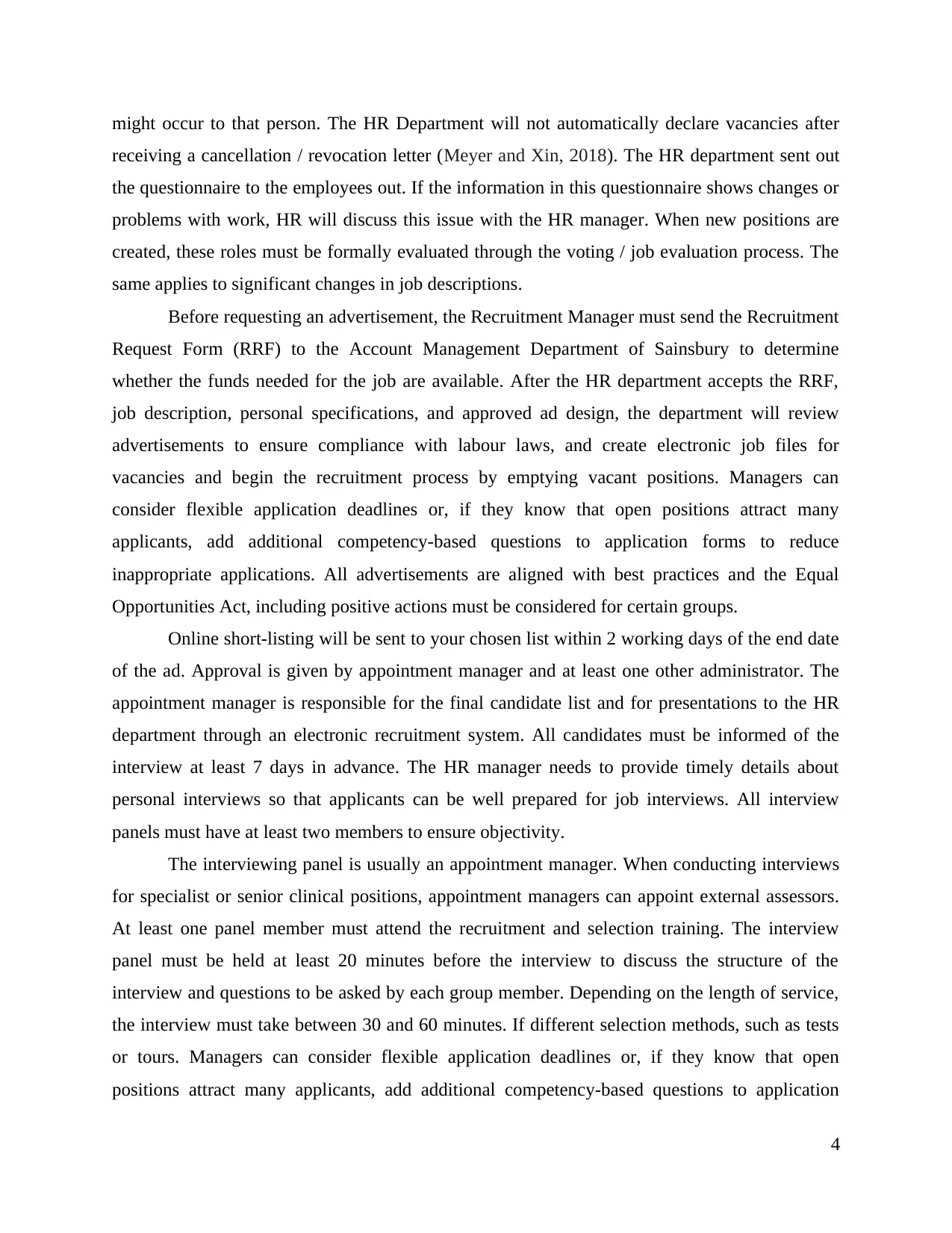
might occur to that person. The HR Department will not automatically declare vacancies after
receiving a cancellation / revocation letter (Meyer and Xin, 2018). The HR department sent out
the questionnaire to the employees out. If the information in this questionnaire shows changes or
problems with work, HR will discuss this issue with the HR manager. When new positions are
created, these roles must be formally evaluated through the voting / job evaluation process. The
same applies to significant changes in job descriptions.
Before requesting an advertisement, the Recruitment Manager must send the Recruitment
Request Form (RRF) to the Account Management Department of Sainsbury to determine
whether the funds needed for the job are available. After the HR department accepts the RRF,
job description, personal specifications, and approved ad design, the department will review
advertisements to ensure compliance with labour laws, and create electronic job files for
vacancies and begin the recruitment process by emptying vacant positions. Managers can
consider flexible application deadlines or, if they know that open positions attract many
applicants, add additional competency-based questions to application forms to reduce
inappropriate applications. All advertisements are aligned with best practices and the Equal
Opportunities Act, including positive actions must be considered for certain groups.
Online short-listing will be sent to your chosen list within 2 working days of the end date
of the ad. Approval is given by appointment manager and at least one other administrator. The
appointment manager is responsible for the final candidate list and for presentations to the HR
department through an electronic recruitment system. All candidates must be informed of the
interview at least 7 days in advance. The HR manager needs to provide timely details about
personal interviews so that applicants can be well prepared for job interviews. All interview
panels must have at least two members to ensure objectivity.
The interviewing panel is usually an appointment manager. When conducting interviews
for specialist or senior clinical positions, appointment managers can appoint external assessors.
At least one panel member must attend the recruitment and selection training. The interview
panel must be held at least 20 minutes before the interview to discuss the structure of the
interview and questions to be asked by each group member. Depending on the length of service,
the interview must take between 30 and 60 minutes. If different selection methods, such as tests
or tours. Managers can consider flexible application deadlines or, if they know that open
positions attract many applicants, add additional competency-based questions to application
4
receiving a cancellation / revocation letter (Meyer and Xin, 2018). The HR department sent out
the questionnaire to the employees out. If the information in this questionnaire shows changes or
problems with work, HR will discuss this issue with the HR manager. When new positions are
created, these roles must be formally evaluated through the voting / job evaluation process. The
same applies to significant changes in job descriptions.
Before requesting an advertisement, the Recruitment Manager must send the Recruitment
Request Form (RRF) to the Account Management Department of Sainsbury to determine
whether the funds needed for the job are available. After the HR department accepts the RRF,
job description, personal specifications, and approved ad design, the department will review
advertisements to ensure compliance with labour laws, and create electronic job files for
vacancies and begin the recruitment process by emptying vacant positions. Managers can
consider flexible application deadlines or, if they know that open positions attract many
applicants, add additional competency-based questions to application forms to reduce
inappropriate applications. All advertisements are aligned with best practices and the Equal
Opportunities Act, including positive actions must be considered for certain groups.
Online short-listing will be sent to your chosen list within 2 working days of the end date
of the ad. Approval is given by appointment manager and at least one other administrator. The
appointment manager is responsible for the final candidate list and for presentations to the HR
department through an electronic recruitment system. All candidates must be informed of the
interview at least 7 days in advance. The HR manager needs to provide timely details about
personal interviews so that applicants can be well prepared for job interviews. All interview
panels must have at least two members to ensure objectivity.
The interviewing panel is usually an appointment manager. When conducting interviews
for specialist or senior clinical positions, appointment managers can appoint external assessors.
At least one panel member must attend the recruitment and selection training. The interview
panel must be held at least 20 minutes before the interview to discuss the structure of the
interview and questions to be asked by each group member. Depending on the length of service,
the interview must take between 30 and 60 minutes. If different selection methods, such as tests
or tours. Managers can consider flexible application deadlines or, if they know that open
positions attract many applicants, add additional competency-based questions to application
4
⊘ This is a preview!⊘
Do you want full access?
Subscribe today to unlock all pages.

Trusted by 1+ million students worldwide
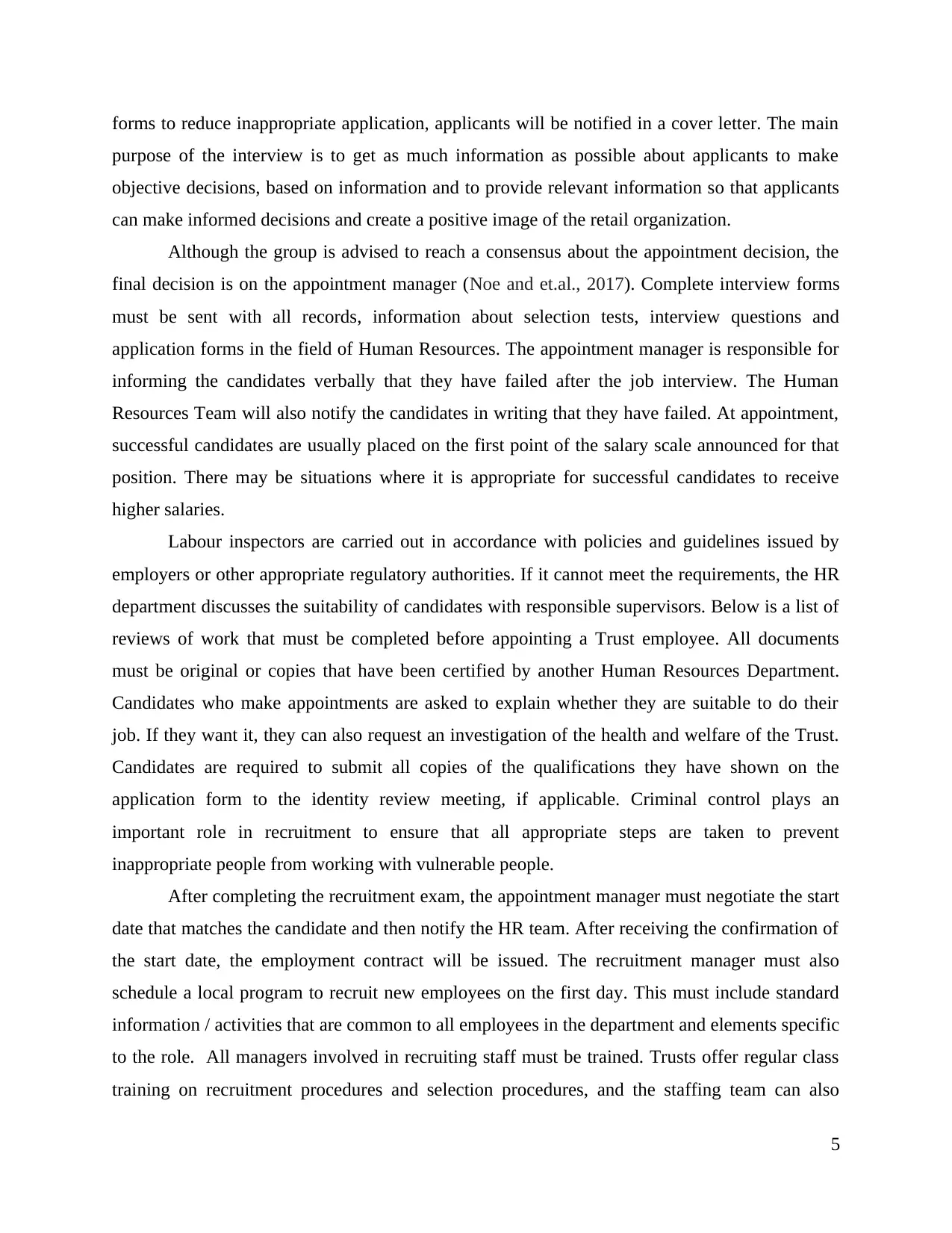
forms to reduce inappropriate application, applicants will be notified in a cover letter. The main
purpose of the interview is to get as much information as possible about applicants to make
objective decisions, based on information and to provide relevant information so that applicants
can make informed decisions and create a positive image of the retail organization.
Although the group is advised to reach a consensus about the appointment decision, the
final decision is on the appointment manager (Noe and et.al., 2017). Complete interview forms
must be sent with all records, information about selection tests, interview questions and
application forms in the field of Human Resources. The appointment manager is responsible for
informing the candidates verbally that they have failed after the job interview. The Human
Resources Team will also notify the candidates in writing that they have failed. At appointment,
successful candidates are usually placed on the first point of the salary scale announced for that
position. There may be situations where it is appropriate for successful candidates to receive
higher salaries.
Labour inspectors are carried out in accordance with policies and guidelines issued by
employers or other appropriate regulatory authorities. If it cannot meet the requirements, the HR
department discusses the suitability of candidates with responsible supervisors. Below is a list of
reviews of work that must be completed before appointing a Trust employee. All documents
must be original or copies that have been certified by another Human Resources Department.
Candidates who make appointments are asked to explain whether they are suitable to do their
job. If they want it, they can also request an investigation of the health and welfare of the Trust.
Candidates are required to submit all copies of the qualifications they have shown on the
application form to the identity review meeting, if applicable. Criminal control plays an
important role in recruitment to ensure that all appropriate steps are taken to prevent
inappropriate people from working with vulnerable people.
After completing the recruitment exam, the appointment manager must negotiate the start
date that matches the candidate and then notify the HR team. After receiving the confirmation of
the start date, the employment contract will be issued. The recruitment manager must also
schedule a local program to recruit new employees on the first day. This must include standard
information / activities that are common to all employees in the department and elements specific
to the role. All managers involved in recruiting staff must be trained. Trusts offer regular class
training on recruitment procedures and selection procedures, and the staffing team can also
5
purpose of the interview is to get as much information as possible about applicants to make
objective decisions, based on information and to provide relevant information so that applicants
can make informed decisions and create a positive image of the retail organization.
Although the group is advised to reach a consensus about the appointment decision, the
final decision is on the appointment manager (Noe and et.al., 2017). Complete interview forms
must be sent with all records, information about selection tests, interview questions and
application forms in the field of Human Resources. The appointment manager is responsible for
informing the candidates verbally that they have failed after the job interview. The Human
Resources Team will also notify the candidates in writing that they have failed. At appointment,
successful candidates are usually placed on the first point of the salary scale announced for that
position. There may be situations where it is appropriate for successful candidates to receive
higher salaries.
Labour inspectors are carried out in accordance with policies and guidelines issued by
employers or other appropriate regulatory authorities. If it cannot meet the requirements, the HR
department discusses the suitability of candidates with responsible supervisors. Below is a list of
reviews of work that must be completed before appointing a Trust employee. All documents
must be original or copies that have been certified by another Human Resources Department.
Candidates who make appointments are asked to explain whether they are suitable to do their
job. If they want it, they can also request an investigation of the health and welfare of the Trust.
Candidates are required to submit all copies of the qualifications they have shown on the
application form to the identity review meeting, if applicable. Criminal control plays an
important role in recruitment to ensure that all appropriate steps are taken to prevent
inappropriate people from working with vulnerable people.
After completing the recruitment exam, the appointment manager must negotiate the start
date that matches the candidate and then notify the HR team. After receiving the confirmation of
the start date, the employment contract will be issued. The recruitment manager must also
schedule a local program to recruit new employees on the first day. This must include standard
information / activities that are common to all employees in the department and elements specific
to the role. All managers involved in recruiting staff must be trained. Trusts offer regular class
training on recruitment procedures and selection procedures, and the staffing team can also
5
Paraphrase This Document
Need a fresh take? Get an instant paraphrase of this document with our AI Paraphraser
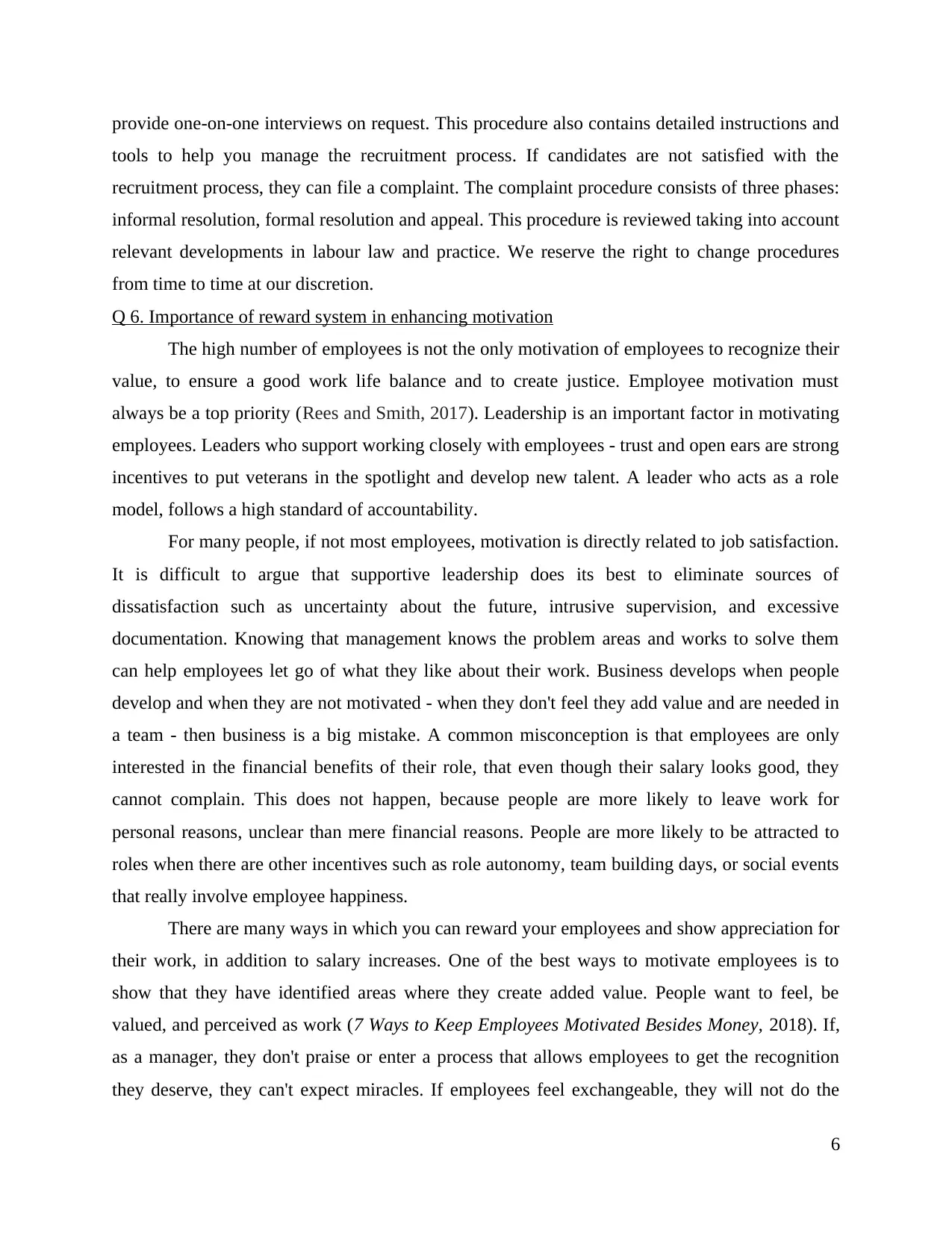
provide one-on-one interviews on request. This procedure also contains detailed instructions and
tools to help you manage the recruitment process. If candidates are not satisfied with the
recruitment process, they can file a complaint. The complaint procedure consists of three phases:
informal resolution, formal resolution and appeal. This procedure is reviewed taking into account
relevant developments in labour law and practice. We reserve the right to change procedures
from time to time at our discretion.
Q 6. Importance of reward system in enhancing motivation
The high number of employees is not the only motivation of employees to recognize their
value, to ensure a good work life balance and to create justice. Employee motivation must
always be a top priority (Rees and Smith, 2017). Leadership is an important factor in motivating
employees. Leaders who support working closely with employees - trust and open ears are strong
incentives to put veterans in the spotlight and develop new talent. A leader who acts as a role
model, follows a high standard of accountability.
For many people, if not most employees, motivation is directly related to job satisfaction.
It is difficult to argue that supportive leadership does its best to eliminate sources of
dissatisfaction such as uncertainty about the future, intrusive supervision, and excessive
documentation. Knowing that management knows the problem areas and works to solve them
can help employees let go of what they like about their work. Business develops when people
develop and when they are not motivated - when they don't feel they add value and are needed in
a team - then business is a big mistake. A common misconception is that employees are only
interested in the financial benefits of their role, that even though their salary looks good, they
cannot complain. This does not happen, because people are more likely to leave work for
personal reasons, unclear than mere financial reasons. People are more likely to be attracted to
roles when there are other incentives such as role autonomy, team building days, or social events
that really involve employee happiness.
There are many ways in which you can reward your employees and show appreciation for
their work, in addition to salary increases. One of the best ways to motivate employees is to
show that they have identified areas where they create added value. People want to feel, be
valued, and perceived as work (7 Ways to Keep Employees Motivated Besides Money, 2018). If,
as a manager, they don't praise or enter a process that allows employees to get the recognition
they deserve, they can't expect miracles. If employees feel exchangeable, they will not do the
6
tools to help you manage the recruitment process. If candidates are not satisfied with the
recruitment process, they can file a complaint. The complaint procedure consists of three phases:
informal resolution, formal resolution and appeal. This procedure is reviewed taking into account
relevant developments in labour law and practice. We reserve the right to change procedures
from time to time at our discretion.
Q 6. Importance of reward system in enhancing motivation
The high number of employees is not the only motivation of employees to recognize their
value, to ensure a good work life balance and to create justice. Employee motivation must
always be a top priority (Rees and Smith, 2017). Leadership is an important factor in motivating
employees. Leaders who support working closely with employees - trust and open ears are strong
incentives to put veterans in the spotlight and develop new talent. A leader who acts as a role
model, follows a high standard of accountability.
For many people, if not most employees, motivation is directly related to job satisfaction.
It is difficult to argue that supportive leadership does its best to eliminate sources of
dissatisfaction such as uncertainty about the future, intrusive supervision, and excessive
documentation. Knowing that management knows the problem areas and works to solve them
can help employees let go of what they like about their work. Business develops when people
develop and when they are not motivated - when they don't feel they add value and are needed in
a team - then business is a big mistake. A common misconception is that employees are only
interested in the financial benefits of their role, that even though their salary looks good, they
cannot complain. This does not happen, because people are more likely to leave work for
personal reasons, unclear than mere financial reasons. People are more likely to be attracted to
roles when there are other incentives such as role autonomy, team building days, or social events
that really involve employee happiness.
There are many ways in which you can reward your employees and show appreciation for
their work, in addition to salary increases. One of the best ways to motivate employees is to
show that they have identified areas where they create added value. People want to feel, be
valued, and perceived as work (7 Ways to Keep Employees Motivated Besides Money, 2018). If,
as a manager, they don't praise or enter a process that allows employees to get the recognition
they deserve, they can't expect miracles. If employees feel exchangeable, they will not do the
6
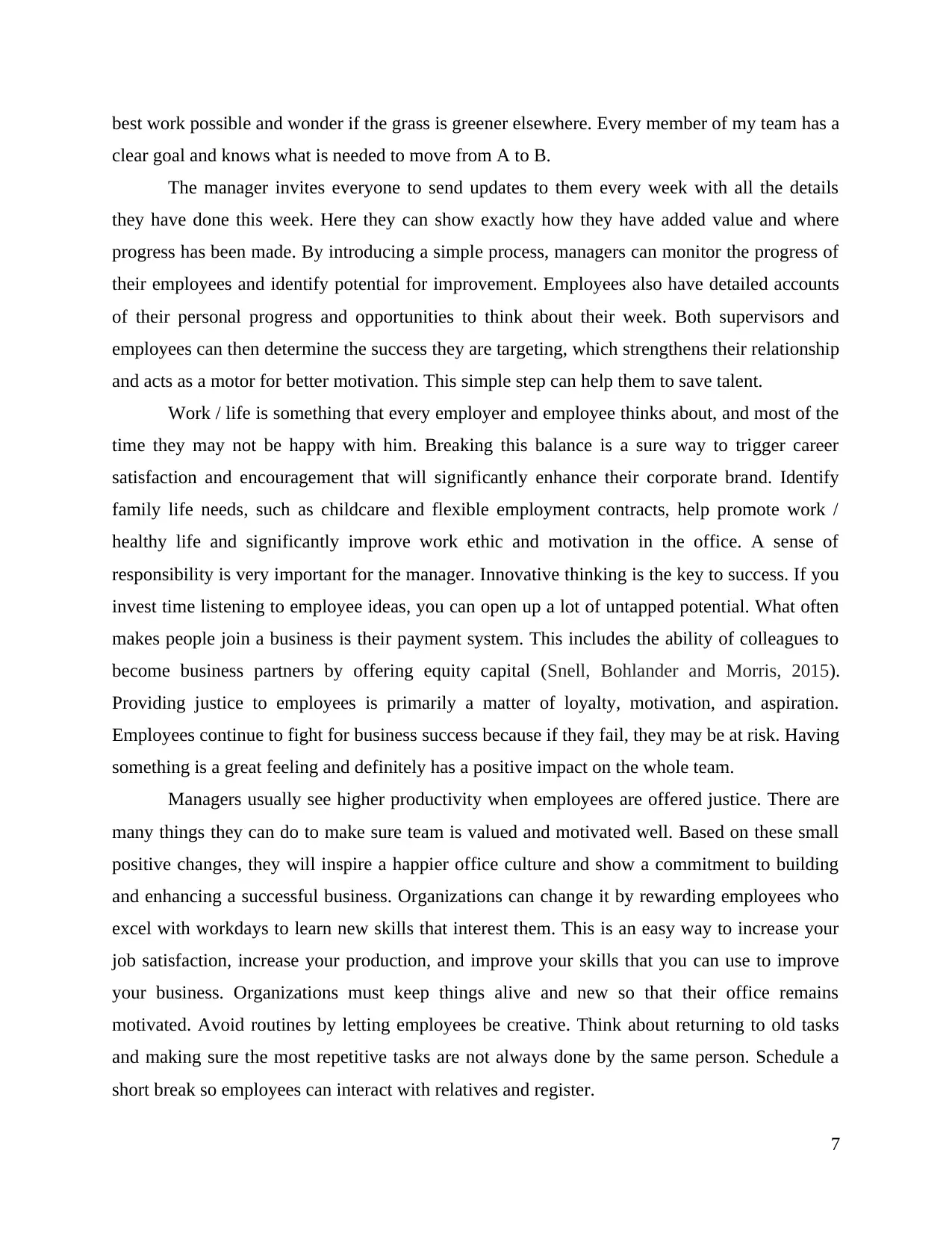
best work possible and wonder if the grass is greener elsewhere. Every member of my team has a
clear goal and knows what is needed to move from A to B.
The manager invites everyone to send updates to them every week with all the details
they have done this week. Here they can show exactly how they have added value and where
progress has been made. By introducing a simple process, managers can monitor the progress of
their employees and identify potential for improvement. Employees also have detailed accounts
of their personal progress and opportunities to think about their week. Both supervisors and
employees can then determine the success they are targeting, which strengthens their relationship
and acts as a motor for better motivation. This simple step can help them to save talent.
Work / life is something that every employer and employee thinks about, and most of the
time they may not be happy with him. Breaking this balance is a sure way to trigger career
satisfaction and encouragement that will significantly enhance their corporate brand. Identify
family life needs, such as childcare and flexible employment contracts, help promote work /
healthy life and significantly improve work ethic and motivation in the office. A sense of
responsibility is very important for the manager. Innovative thinking is the key to success. If you
invest time listening to employee ideas, you can open up a lot of untapped potential. What often
makes people join a business is their payment system. This includes the ability of colleagues to
become business partners by offering equity capital (Snell, Bohlander and Morris, 2015).
Providing justice to employees is primarily a matter of loyalty, motivation, and aspiration.
Employees continue to fight for business success because if they fail, they may be at risk. Having
something is a great feeling and definitely has a positive impact on the whole team.
Managers usually see higher productivity when employees are offered justice. There are
many things they can do to make sure team is valued and motivated well. Based on these small
positive changes, they will inspire a happier office culture and show a commitment to building
and enhancing a successful business. Organizations can change it by rewarding employees who
excel with workdays to learn new skills that interest them. This is an easy way to increase your
job satisfaction, increase your production, and improve your skills that you can use to improve
your business. Organizations must keep things alive and new so that their office remains
motivated. Avoid routines by letting employees be creative. Think about returning to old tasks
and making sure the most repetitive tasks are not always done by the same person. Schedule a
short break so employees can interact with relatives and register.
7
clear goal and knows what is needed to move from A to B.
The manager invites everyone to send updates to them every week with all the details
they have done this week. Here they can show exactly how they have added value and where
progress has been made. By introducing a simple process, managers can monitor the progress of
their employees and identify potential for improvement. Employees also have detailed accounts
of their personal progress and opportunities to think about their week. Both supervisors and
employees can then determine the success they are targeting, which strengthens their relationship
and acts as a motor for better motivation. This simple step can help them to save talent.
Work / life is something that every employer and employee thinks about, and most of the
time they may not be happy with him. Breaking this balance is a sure way to trigger career
satisfaction and encouragement that will significantly enhance their corporate brand. Identify
family life needs, such as childcare and flexible employment contracts, help promote work /
healthy life and significantly improve work ethic and motivation in the office. A sense of
responsibility is very important for the manager. Innovative thinking is the key to success. If you
invest time listening to employee ideas, you can open up a lot of untapped potential. What often
makes people join a business is their payment system. This includes the ability of colleagues to
become business partners by offering equity capital (Snell, Bohlander and Morris, 2015).
Providing justice to employees is primarily a matter of loyalty, motivation, and aspiration.
Employees continue to fight for business success because if they fail, they may be at risk. Having
something is a great feeling and definitely has a positive impact on the whole team.
Managers usually see higher productivity when employees are offered justice. There are
many things they can do to make sure team is valued and motivated well. Based on these small
positive changes, they will inspire a happier office culture and show a commitment to building
and enhancing a successful business. Organizations can change it by rewarding employees who
excel with workdays to learn new skills that interest them. This is an easy way to increase your
job satisfaction, increase your production, and improve your skills that you can use to improve
your business. Organizations must keep things alive and new so that their office remains
motivated. Avoid routines by letting employees be creative. Think about returning to old tasks
and making sure the most repetitive tasks are not always done by the same person. Schedule a
short break so employees can interact with relatives and register.
7
⊘ This is a preview!⊘
Do you want full access?
Subscribe today to unlock all pages.

Trusted by 1+ million students worldwide
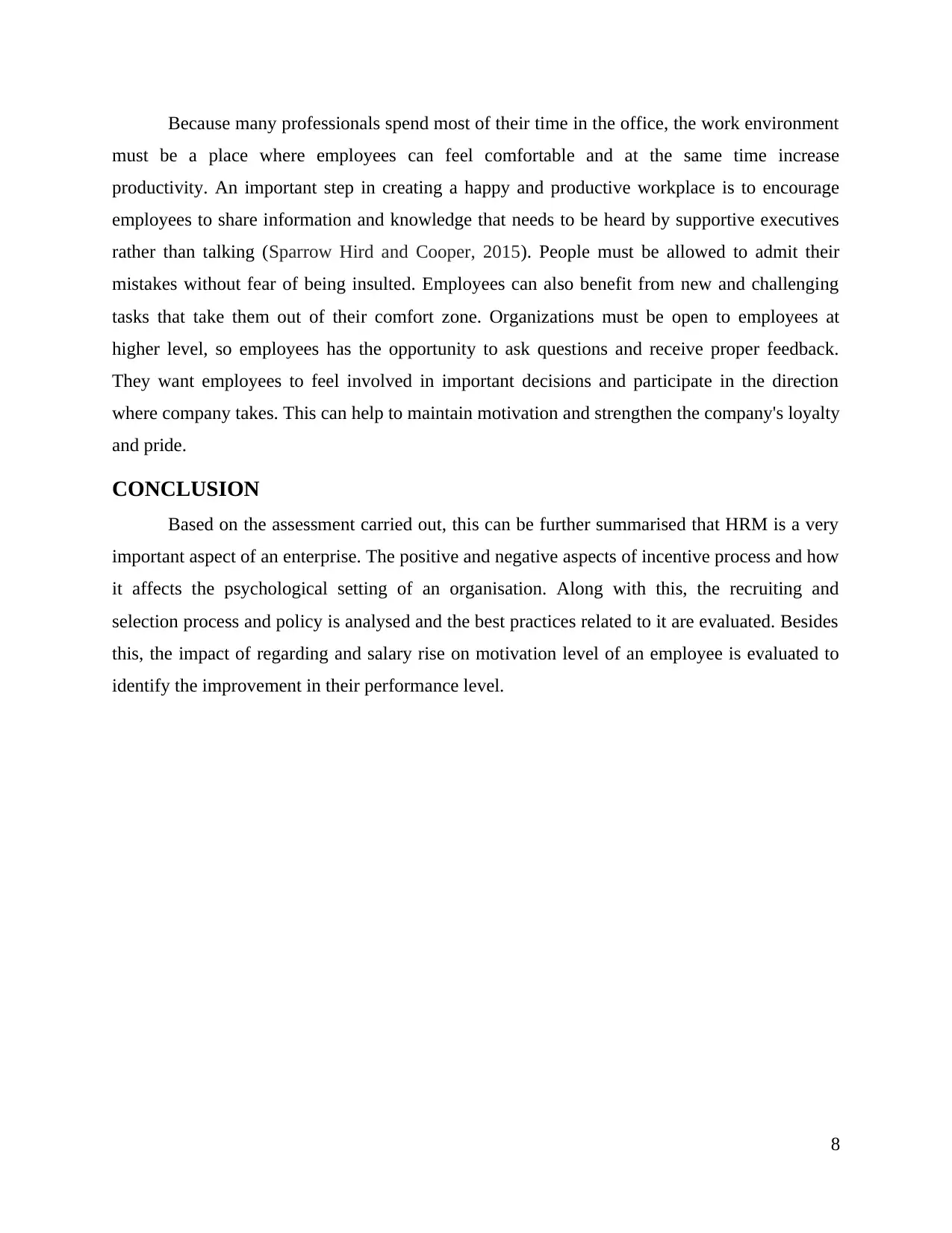
Because many professionals spend most of their time in the office, the work environment
must be a place where employees can feel comfortable and at the same time increase
productivity. An important step in creating a happy and productive workplace is to encourage
employees to share information and knowledge that needs to be heard by supportive executives
rather than talking (Sparrow Hird and Cooper, 2015). People must be allowed to admit their
mistakes without fear of being insulted. Employees can also benefit from new and challenging
tasks that take them out of their comfort zone. Organizations must be open to employees at
higher level, so employees has the opportunity to ask questions and receive proper feedback.
They want employees to feel involved in important decisions and participate in the direction
where company takes. This can help to maintain motivation and strengthen the company's loyalty
and pride.
CONCLUSION
Based on the assessment carried out, this can be further summarised that HRM is a very
important aspect of an enterprise. The positive and negative aspects of incentive process and how
it affects the psychological setting of an organisation. Along with this, the recruiting and
selection process and policy is analysed and the best practices related to it are evaluated. Besides
this, the impact of regarding and salary rise on motivation level of an employee is evaluated to
identify the improvement in their performance level.
8
must be a place where employees can feel comfortable and at the same time increase
productivity. An important step in creating a happy and productive workplace is to encourage
employees to share information and knowledge that needs to be heard by supportive executives
rather than talking (Sparrow Hird and Cooper, 2015). People must be allowed to admit their
mistakes without fear of being insulted. Employees can also benefit from new and challenging
tasks that take them out of their comfort zone. Organizations must be open to employees at
higher level, so employees has the opportunity to ask questions and receive proper feedback.
They want employees to feel involved in important decisions and participate in the direction
where company takes. This can help to maintain motivation and strengthen the company's loyalty
and pride.
CONCLUSION
Based on the assessment carried out, this can be further summarised that HRM is a very
important aspect of an enterprise. The positive and negative aspects of incentive process and how
it affects the psychological setting of an organisation. Along with this, the recruiting and
selection process and policy is analysed and the best practices related to it are evaluated. Besides
this, the impact of regarding and salary rise on motivation level of an employee is evaluated to
identify the improvement in their performance level.
8
Paraphrase This Document
Need a fresh take? Get an instant paraphrase of this document with our AI Paraphraser
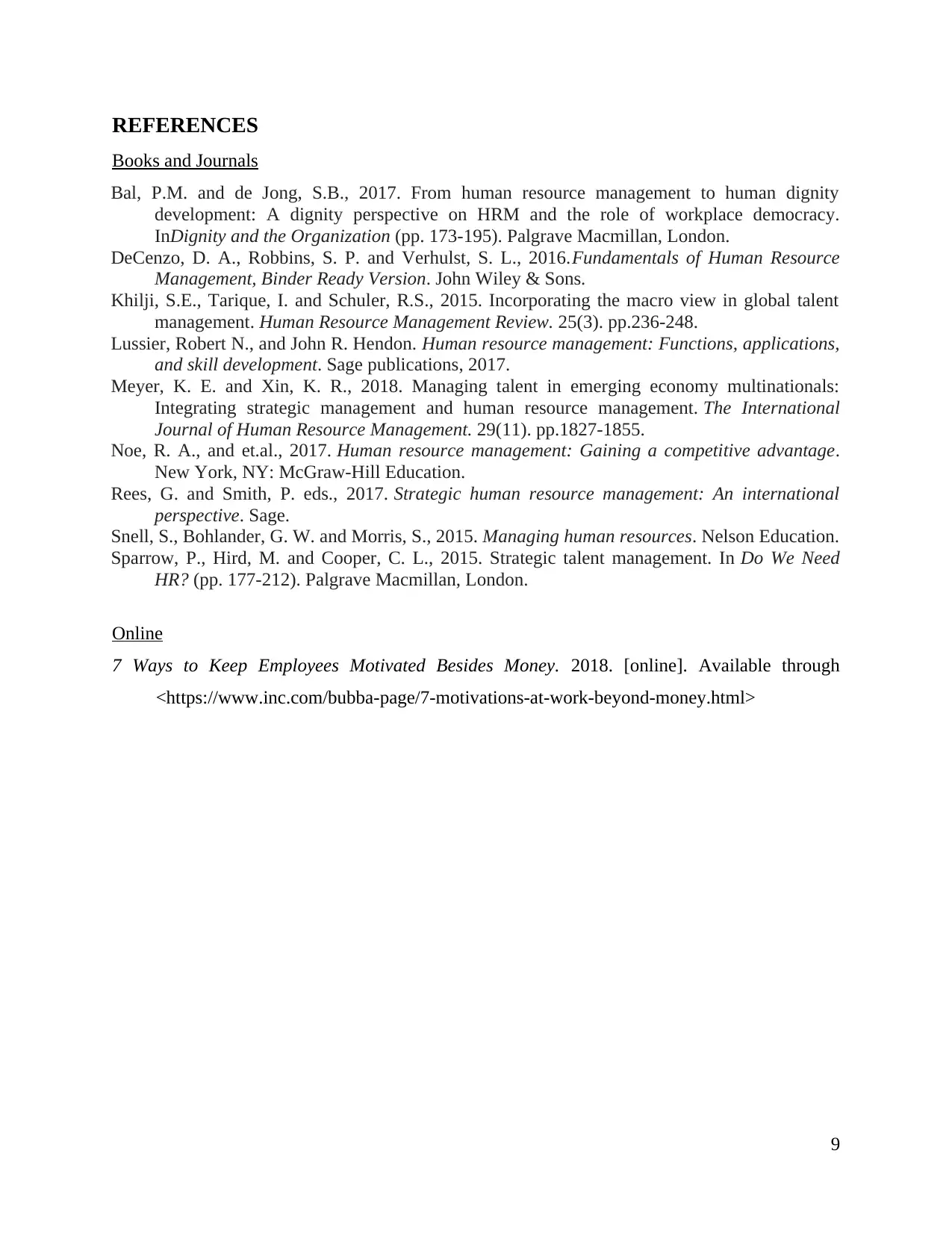
REFERENCES
Books and Journals
Bal, P.M. and de Jong, S.B., 2017. From human resource management to human dignity
development: A dignity perspective on HRM and the role of workplace democracy.
InDignity and the Organization (pp. 173-195). Palgrave Macmillan, London.
DeCenzo, D. A., Robbins, S. P. and Verhulst, S. L., 2016.Fundamentals of Human Resource
Management, Binder Ready Version. John Wiley & Sons.
Khilji, S.E., Tarique, I. and Schuler, R.S., 2015. Incorporating the macro view in global talent
management. Human Resource Management Review. 25(3). pp.236-248.
Lussier, Robert N., and John R. Hendon. Human resource management: Functions, applications,
and skill development. Sage publications, 2017.
Meyer, K. E. and Xin, K. R., 2018. Managing talent in emerging economy multinationals:
Integrating strategic management and human resource management. The International
Journal of Human Resource Management. 29(11). pp.1827-1855.
Noe, R. A., and et.al., 2017. Human resource management: Gaining a competitive advantage.
New York, NY: McGraw-Hill Education.
Rees, G. and Smith, P. eds., 2017. Strategic human resource management: An international
perspective. Sage.
Snell, S., Bohlander, G. W. and Morris, S., 2015. Managing human resources. Nelson Education.
Sparrow, P., Hird, M. and Cooper, C. L., 2015. Strategic talent management. In Do We Need
HR? (pp. 177-212). Palgrave Macmillan, London.
Online
7 Ways to Keep Employees Motivated Besides Money. 2018. [online]. Available through
<https://www.inc.com/bubba-page/7-motivations-at-work-beyond-money.html>
9
Books and Journals
Bal, P.M. and de Jong, S.B., 2017. From human resource management to human dignity
development: A dignity perspective on HRM and the role of workplace democracy.
InDignity and the Organization (pp. 173-195). Palgrave Macmillan, London.
DeCenzo, D. A., Robbins, S. P. and Verhulst, S. L., 2016.Fundamentals of Human Resource
Management, Binder Ready Version. John Wiley & Sons.
Khilji, S.E., Tarique, I. and Schuler, R.S., 2015. Incorporating the macro view in global talent
management. Human Resource Management Review. 25(3). pp.236-248.
Lussier, Robert N., and John R. Hendon. Human resource management: Functions, applications,
and skill development. Sage publications, 2017.
Meyer, K. E. and Xin, K. R., 2018. Managing talent in emerging economy multinationals:
Integrating strategic management and human resource management. The International
Journal of Human Resource Management. 29(11). pp.1827-1855.
Noe, R. A., and et.al., 2017. Human resource management: Gaining a competitive advantage.
New York, NY: McGraw-Hill Education.
Rees, G. and Smith, P. eds., 2017. Strategic human resource management: An international
perspective. Sage.
Snell, S., Bohlander, G. W. and Morris, S., 2015. Managing human resources. Nelson Education.
Sparrow, P., Hird, M. and Cooper, C. L., 2015. Strategic talent management. In Do We Need
HR? (pp. 177-212). Palgrave Macmillan, London.
Online
7 Ways to Keep Employees Motivated Besides Money. 2018. [online]. Available through
<https://www.inc.com/bubba-page/7-motivations-at-work-beyond-money.html>
9
1 out of 11
Related Documents
Your All-in-One AI-Powered Toolkit for Academic Success.
+13062052269
info@desklib.com
Available 24*7 on WhatsApp / Email
![[object Object]](/_next/static/media/star-bottom.7253800d.svg)
Unlock your academic potential
Copyright © 2020–2025 A2Z Services. All Rights Reserved. Developed and managed by ZUCOL.





